Could Cryptids Colonize Mars? Scientists Map the Possibilities
Scientists explore whether cryptids could survive on Mars by examining their mythical traits and adaptability. While some legends suggest cryptids could develop resilience through specialized senses and camouflage, the planet’s harsh environment presents major challenges like radiation, extreme temperatures, and scarce water. Subsurface ecosystems offer potential hiding spots, but technological and ethical hurdles remain. If you’re curious how myth might meet science, there’s more to uncover about the fascinating possibilities ahead.
Key TakeawaysCryptids’ biological traits, like adaptability and resilience, could theoretically support survival if they evolved or were bioengineered for Martian conditions.Subsurface habitats on Mars might provide suitable environments for cryptids, shielding them from radiation and extreme temperatures.Advanced terraforming and biosynthesis technologies could create habitable ecosystems, potentially enabling cryptid colonization.Ethical concerns and ecological risks of introducing cryptids to Mars pose significant challenges to their hypothetical colonization.The mythological symbolism of cryptids inspires scientific exploration and bioengineering efforts to explore extraterrestrial life possibilities.The Mythology and Origins of Cryptids
Cryptids are creatures whose existence is debated, often rooted in ancient myths, folklore, and local legends. Their mythical origins trace back centuries, shaping stories that blend reality and imagination. You might see cryptid symbolism as representing fears, cultural values, or natural mysteries that early societies couldn’t explain. For example, legendary beings like the Loch Ness Monster or Bigfoot reflect humanity’s fascination with the unknown. These creatures often symbolize more than just stories—they embody cultural identity, fears, and hopes. By understanding their mythical origins, you gain insight into how different civilizations interpreted the world around them. Cryptids serve as symbols of mystery and the enduring human desire to explore what lies beyond known boundaries.
Biological Traits and Adaptability of Cryptids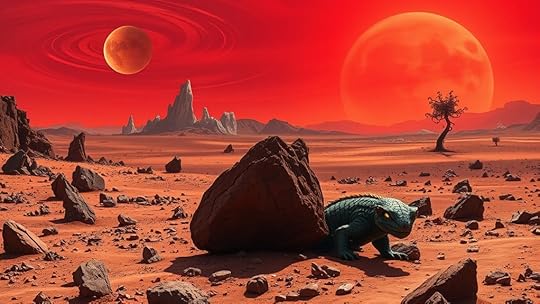
Many cryptids exhibit remarkable biological traits that enable them to survive in their mysterious habitats, often displaying adaptations that blur the line between reality and myth. These cryptid metaphors symbolize resilience and mystery, rooted in folklore origins that fuel imaginative survival stories. Some cryptids possess extraordinary senses, like heightened hearing or night vision, allowing them to navigate hostile environments unseen. Others have evolved durable skins or camouflage techniques, making them nearly invisible—traits that could theoretically aid in extraterrestrial survival. Their biological traits reflect a capacity for rapid adaptation, blending mythic qualities with potential biological plausibility. This versatility suggests that, if cryptids existed, their adaptability might enable them to survive in extreme environments like Mars, where resilience is essential for long-term colonization.
Environmental Conditions on Mars and Their Challenges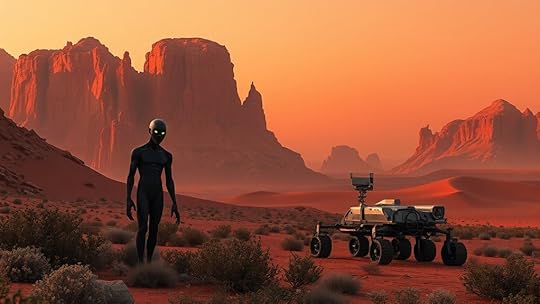
Mars’s surface is full of hazards, from its rocky terrain to dust storms that can strike without warning. The thin atmosphere offers little protection and makes breathing difficult, forcing you to find or create reliable resources. Understanding these environmental challenges is vital for cryptids to survive and thrive on the Red Planet.
Surface Composition and HazardsHave you ever wondered what makes the Martian surface so hostile to life and exploration? The terrain is a relentless mix of sharp, rocky landscapes, fine dust, and corrosive chemicals that erode equipment and hide hazards. Cryptid folklore often describes creatures with mythical resilience, capable of surviving extreme conditions, but Mars challenges even the toughest legends. Its surface contains perchlorates and heavy metals, which pose serious health risks and complicate colonization efforts. The dust storms can blanket the planet for weeks, reducing visibility and damaging machinery. These hazards demand advanced protective measures for any hypothetical cryptid explorers. Understanding the surface composition helps identify potential safe zones, but the hostile environment remains a significant barrier to survival—legend or not.
Atmospheric Challenges and ResourcesAlthough the atmosphere on Mars is thin and composed mainly of carbon dioxide, it presents significant challenges for any form of life or exploration. The lack of oxygen and extreme temperatures threaten cryptid habitats and mythic evolution. Without a stable atmosphere, sustaining life becomes nearly impossible. You face a hostile environment where resources are scarce, and survival hinges on technological adaptation. Consider this:
ChallengeImpactSolutionThin, CO2-rich atmosphereBreeds suffocation, limits respirationTerraforming or sealed habitatsExtreme temperaturesCauses structural stress, energy drainInsulation, energy sourcesLimited water resourcesRestricts life support systemsIce mining, recyclingThese atmospheric hurdles test the mythic resilience of cryptids, threatening their habitat and evolution on Mars.
Possibility of Cryptid Survival in Martian Atmospheres
You might wonder if cryptids can survive Mars’s thin, unbreathable atmosphere. Their ability to resist extreme conditions depends on how well they adapt to low pressure and limited oxygen. Exploring their potential resilience could reveal surprising survival strategies.
Atmospheric Adaptation ChallengesCould cryptids realistically survive in the thin, harsh atmosphere of Mars? Considering their cryptid folklore and mythological origins, survival seems unlikely without major adaptation. Mars’ atmosphere is mostly carbon dioxide, with trace amounts of oxygen, making breathing difficult. Cryptids from Earth’s legends often rely on environments with breathable air and stable weather patterns. Their mythological origins suggest they evolved in conditions vastly different from Mars, so adapting to its extreme cold, radiation, and low pressure would be a significant challenge. Without biological changes or technological support, their natural resilience would be insufficient. The atmospheric adaptation challenges highlight just how incompatible Earth-based cryptids are with Martian conditions, emphasizing that myth and folklore alone can’t guarantee their survival on a planet so fundamentally different.
Potential Cryptid ResilienceWhile the harsh conditions of Mars pose significant hurdles, some cryptids might possess inherent traits that could give them a slim chance of survival. Drawing from cryptid folklore and mythological origins, these creatures often exhibit resilience beyond natural limits. Their legendary adaptability might allow them to endure extreme environments, including low pressure and radiation.
You might imagine cryptids with:
*Unbreakable biological armor* that shields against radiation*Superhuman regenerative abilities* for rapid healing*Unusual metabolic processes* that thrive on minimal resources*Mystical camouflage* to hide from hostile surroundings*Ancient mythological origins* hinting at survival through supernatural meansWhile speculative, these traits could give cryptids a fighting chance, fueling hope that some legendary beings might endure beyond Earth.
Potential for Cryptids to Thrive in Subsurface Ecosystems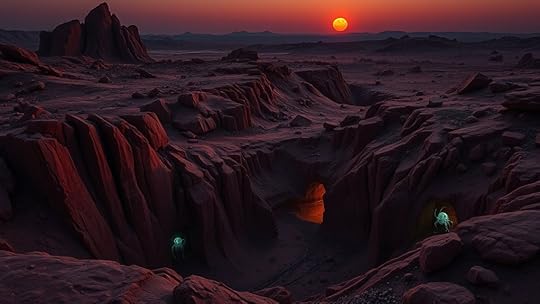
Subsurface ecosystems on Mars could offer cryptids a surprisingly stable environment, shielded from harsh surface conditions like radiation and extreme temperatures. These hidden habitats might support cryptid ecology by providing consistent warmth, moisture, and nutrients, making survival feasible. Since many folklore origins describe cryptids living in remote, underground areas, it’s plausible that similar ecosystems could sustain them on Mars. The darkness and isolation could mimic the environments linked to legends of mysterious creatures lurking beneath the earth. If cryptids evolved or adapted to underground habitats on Earth, they might have the resilience needed to thrive in Martian subsurface environments. This potential underscores how such ecosystems could serve as refuges, enabling cryptids to persist beyond surface challenges and supporting the idea of their extraterrestrial survival.
Genetic Engineering and the Idea of Cryptid Introduction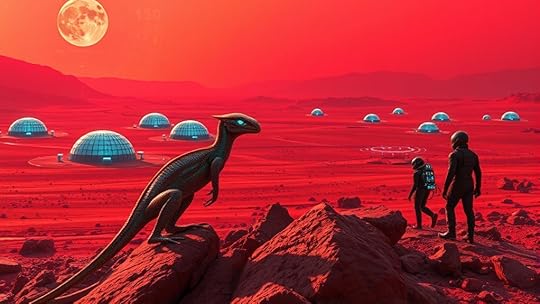
Advances in genetic engineering open the possibility of introducing cryptids to extraterrestrial environments like Mars, transforming speculative ideas into feasible experiments. With modern techniques, you could modify DNA inspired by cryptid mythology to create resilient creatures suited for alien worlds. This approach sparks excitement and fear, challenging your understanding of life’s boundaries. Consider these emotional impacts:
Awe at bringing mythical creatures into realityAnxiety over unforeseen ecological consequencesWonder about rewriting biology itselfCuriosity about bridging myth and scienceEthical dilemmas of playing godEthical and Scientific Considerations of Interplanetary Colonization
As humanity pushes forward with interplanetary colonization, ethical and scientific considerations become increasingly critical. You must weigh the implications of introducing cryptid mythology into new ecosystems, questioning whether it’s right to alter extraterrestrial environments with potentially unknown life forms. Interstellar ethics demand that we respect the intrinsic value of any native or cryptid-like life, avoiding harm or unintended consequences. Scientific considerations involve understanding the biological complexities and risks of integrating cryptids into Mars’s environment, ensuring we don’t cause irreversible damage. Balancing curiosity with responsibility is essential. As you contemplate colonization, remember that your decisions could set precedents for respecting extraterrestrial life, challenging you to act ethically while pushing the boundaries of scientific discovery.
Comparing Earth’s Ecosystems and Martian Environments
Earth’s ecosystems are highly diverse and finely balanced, supporting a wide array of life forms through complex interactions and stable conditions. On Mars, environments are harsh—dominated by extreme temperatures, radiation, and scarce water—making survival challenging. This stark contrast influences cryptid mythology, fueling speculation about mysterious creatures lurking in Earth’s rich habitats, unlike anything possible on Mars. When considering cryptid biology, Earth’s varied ecosystems nurture unique adaptations not feasible on the Red Planet’s barren surface.
Feel a sense of wonder at Earth’s vibrant life versus Mars’s desolationImagine cryptids thriving in lush, protected habitats, unlike barren landscapesContemplate how environment shapes cryptid evolution and mythologyRecognize the importance of ecological stability for diverse lifeConsider how alien environments challenge our understanding of cryptid biologyTechnological Advances That Could Support Exotic Life FormsEarth’s diverse, stable ecosystems foster unique cryptid adaptations unseen on Mars’s barren, extreme landscape.
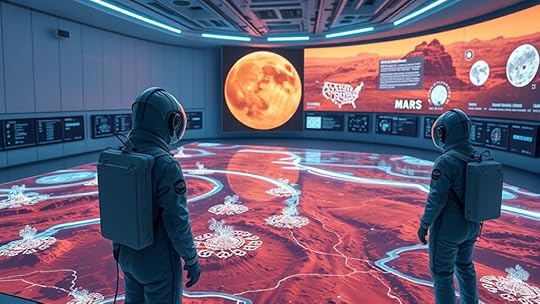
You’ll need cutting-edge terraforming innovations to create a hospitable environment for cryptids and other exotic life forms. Advanced biosynthesis techniques can generate essential nutrients and materials, supporting their survival amid harsh conditions. Together, these technologies could turn Mars into a viable new home for life beyond Earth.
Terraforming Innovations Enable SurvivalRecent technological advances in terraforming are opening new possibilities for supporting exotic life forms on Mars. These innovations could enable cryptid folklore and creatures of mythical origins to survive beyond Earth. Imagine harnessing atmospheric processors that create habitable zones, or bio-domes that mimic Earth’s environments perfectly. You might see genetically engineered organisms designed to thrive in Martian soil, blurring the line between myth and science. These breakthroughs could turn Mars into a haven for legendary beings long thought to be only stories. The thrill of encountering cryptids in new worlds fuels curiosity and adventure.
Creating oxygen-rich atmospheres that sustain lifeDeveloping resilient bio-domes for safe habitatsEngineering plants to adapt to Martian conditionsUsing energy sources to support exotic ecosystemsPreserving mythical origins in a new frontierAdvanced Biosynthesis TechniquesAdvanced biosynthesis techniques are transforming the way we can support exotic life forms on Mars by enabling the precise creation of complex biological molecules in controlled environments. These innovations could help recreate mythical creatures or cryptid origins, giving them a biological foundation suited for extraterrestrial life. By manipulating genetic sequences, you can engineer organisms with unique traits, like resilient skin or energy-efficient metabolisms, supporting cryptid survival beyond Earth. Imagine a table illustrating these possibilities:
TraitFunctionEnhanced resilienceSurvives harsh Martian conditionsBioluminescenceCommunicates in darknessAdaptive metabolismUses scarce resources efficientlyThis technology opens the door to designing life forms that blend myth and science, pushing the boundaries of what’s biologically possible on Mars.
Speculative Scenarios: From Folklore to Future Space Missions
While folklore often sparks curiosity about mysterious creatures, imagining them settling on Mars pushes the boundaries of both science and storytelling. You might wonder how cryptid folklore and mythological creatures could inspire future space missions or influence our view of extraterrestrial life. These stories evoke a sense of wonder and challenge scientific norms, blurring lines between imagination and possibility. Could legends of elusive beings inspire bioengineering efforts or habitat designs? Or spark debates about the ethical implications of encountering unknown life forms? As you consider these scenarios, think about:
The emotional power of mythological creatures inspiring innovationFolklore shaping new scientific hypothesesThe potential for cryptids to symbolize uncharted territoriesHow stories might influence our approach to extraterrestrial explorationThe blend of myth and science transforming future missionsFrequently Asked QuestionsCould Cryptids Adapt Genetically to Survive Extreme Martian Conditions?You wonder if cryptids could adapt genetically to survive Mars’s harsh environment. While genetic engineering might help, natural adaptation strategies are limited by the extreme conditions. Cryptids would need significant genetic modifications to handle radiation, low temperatures, and scarce resources. Although fascinating, the reality is that without advanced biotech, these creatures wouldn’t easily survive or thrive on Mars, making their colonization highly unlikely with current technology.
What Specific Cryptid Species Are Most Likely to Colonize Mars?You might wonder which cryptid species are most likely to colonize Mars. Considering cryptid habitat and behavior, creatures with adaptable, resilient traits could thrive. For instance, cryptids that prefer underground or rocky environments might find suitable shelter, while those with minimal food needs and low activity levels could survive harsh conditions. These traits increase their chances of enduring Mars’ extreme environment, making them the most probable cryptids to establish a new habitat there.
How Would Cryptids Impact Potential Martian Ecosystems?Did you know that introducing cryptids could drastically alter martian ecosystems? Their cryptid behavior, such as unique feeding habits or social structures, might disrupt the delicate ecosystem balance. If cryptids adapt to Mars, they could compete with native microbes for resources or create new ecological niches. Understanding these impacts helps scientists assess risks and benefits, ensuring that any potential colonization supports a sustainable and balanced environment on the Red Planet.
Are There Existing Technologies Capable of Supporting Cryptid Life on Mars?You might wonder if current technologies can support cryptid life on Mars. While terraforming techniques aim to modify the planet’s environment, they’re still in early stages. Scientists are also studying extraterrestrial microbiomes to understand potential life forms. Although we lack specific methods for cryptids, advancements in these areas could eventually create habitats suitable for unknown or mythical creatures, making Mars a more accommodating environment in the future.
What Are the Legal Implications of Introducing Terrestrial Cryptids to Mars?You need to contemplate space law and ethical considerations before introducing terrestrial cryptids to Mars. Space law, like the Outer Space Treaty, emphasizes protecting extraterrestrial environments, so introducing cryptids could violate these regulations. Ethically, you must weigh potential ecological impacts and the moral responsibility of preserving Mars’s existing conditions. You’d be responsible for ensuring that your actions don’t harm potential Martian life or compromise future scientific research.
ConclusionAs you ponder the legends and the science, remember that venturing to colonize Mars with cryptids isn’t just a leap of faith but a journey into the unknown, like Galileo gazing through his telescope into uncharted skies. While your imagination might conjure mythical beasts roaming alien caves, the reality demands cutting-edge tech and ethical debates. So, as you stand on this precipice, keep your eyes on the horizon—history’s pages may soon reveal what lies beyond our world.



